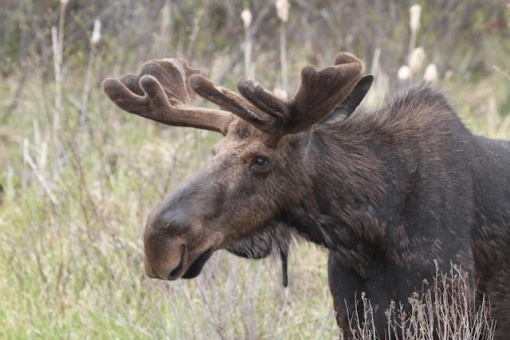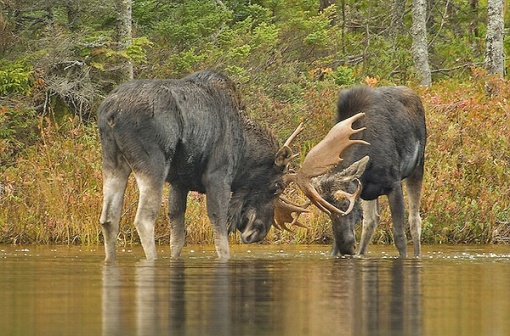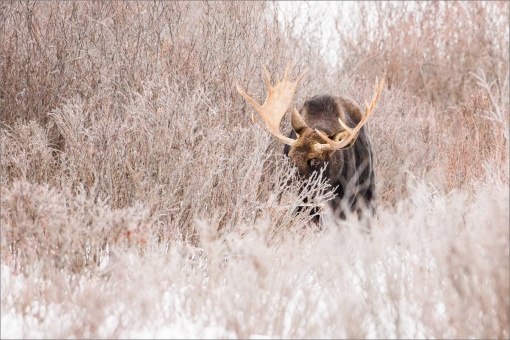Giant of the Northern Forest
Alces alces, also known as the moose, is one of the most interesting organisms in the world. Standing at approximately six feet tall at the shoulder, weighing up to 1,800 pounds, and being about ten feet long, moose are the largest member of the deer family.
The common name of Alces alces is moose. “Moose” comes from the Algonquian word “mus” or “moos”, which means “twig-eater” or eater of twigs.
In Latin, alces means “elk”. This can sometimes cause confusion when talking about Alces alces because European countries refer to it as “elk” and North Americans refer to it as “moose”. This situation is the exact reason scientific names are used. No matter where you are in the world or what language you speak, Alces alces will refer to this organism!
General Characteristics of Alces alces:
Alces alces has many characteristics that make it quite unique and easy to identify. First off, you can identify them by their huge antlers. The antlers can get up to as wide as five feet! However, only the male moose, also known as bulls, grow antlers.
Another characteristic of the moose is their dark brown fur coat, however only mature moose have dark brown coats. Young moose, called calves, have light brown fur. It darkens as they mature. The fur is actually hollow and allows for many features, such as keeping them warm during the winter and for buoyancy when in water.
One of the oddest characteristics of Alces alces is the presence of the dewlap, also called the bell. The dewlap is the flap of skin that hangs under a moose’s chin. The function of the dewlap is unknown, but there are theories for it. One theory is that the dewlap is used for communication during the rut, both by sight and smell. During the rut a bull will rub the cow with his chin, also called chinning, and the dewlap transfers this bull’s scent to the female. Another theory is that the size and shape of the dewlap may be an indicator of dominance to other bulls, just like the size of the antlers are.
Listed below are other factors including conservation status.
Factoid:
Moose are good swimmers and can move in the water at 6 miles per hour for as much as two hours at a time.
Conservation Status:
Stable.
Population:
Total population unknown.
Threats:
Moose once lived throughout most of the United States and Canada, but the species range has dwindled because of uncontrolled hunting for sport and food and because of land development. In the 19th century, ranchers shot them to reduce competition with livestock for food. Moose typically inhabit boreal and mixed deciduous forests of the Northern Hemisphere in temperate to subarctic climates.
Survival:
Moose live up to 20 years.
Moose are the largest members of the deer family, about the size of a horse. They have thick coats of long, dark-brown hair, humped shoulders, and long thin legs. Their huge muzzles, big ears, and broad flat antlers, as well as their large size, set them apart from other members of the deer family. Both males and females also have a flap of skin called a bell that hangs beneath the throat. The bell is used for communication through the scents released from it. Their antlers, grown only by the bulls, can reach 4 to 5 feet from end to end. The record length is 6 feet 9 inches. Moose use their antlers to thrash brush, fight for mates, and root plants from the pond floor. The antlers are shed around November or December, after mating season has ended.
Males weigh 900 to 1,400 pounds and females 700 to 1,100 pounds. One or two calves are born every spring, and newborns weigh 24 to 35 pounds.
Cool weather seems to suit moose well. They inhabit spruce forests, swamps, and aspen and willow thickets throughout most of Canada, Maine, Minnesota, Alaska, and the Rocky Mountains in Utah and Colorado. They migrate seasonally up and down mountain slopes. They also enjoy wallowing in mud and water, especially when insects bother them during warm weather.
In summer, when moose hang around ponds and marshes, they eat willows and aquatic vegetation like water lily leaves. In the winter they eat mostly woody plants like twigs, buds, and the bark of willow, balsam, aspen, dogwood, birch, cherry, and maple trees.
Moose are generally shy animals and usually move away from humans. However, cows with calves may charge if they feel threatened, and bulls can be dangerous during the breeding season. The most common moose predators are wolves, bears, and humans. Unlike most other deer species, moose are solitary animals and do not form herds.
National Parks:
In North America, Moose are found in North Cascades National Park, WA; Rocky Mountain National Park, CO; Voyageurs National Park, MN; Kenai Fjords National Park, AK; Glacier Bay National Park and Preserve, AK; Katmai National Park and Preserve, AK; Noatak National Preserve, AK; Gates of the Arctic National Park and Preserve, AK; Denali National Park and Preserve, AK; Lake Clark National Park and Preserve, AK; Isle Royale National Park, MI; Yukon-Charley Rivers National Preserve, AK; Bering Land Bridge National Preserve, AK; Aniakchak National Monument and Preserve, AK; Acadia National Park, ME; and the northern part of Appalachian National Scenic Trail, ME.
Moose have been reintroduced to some of their former habitats. Currently, most moose are found in Canada, Alaska, Scandinavia and Russia as shown on the map below.
Go to Classification to see where the moose fits into the grand scheme of things!
Go to Mooseworld.com for even more information on Alces alces!
Go to National Geographic for more information also!
***


























